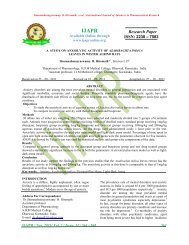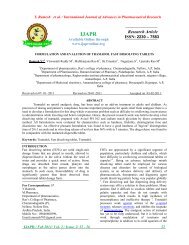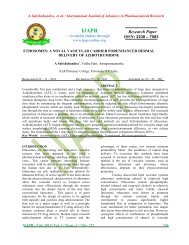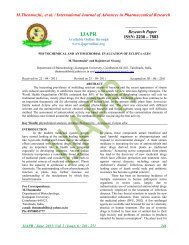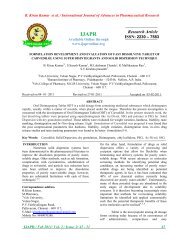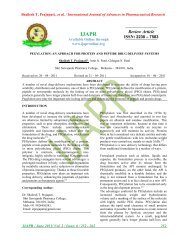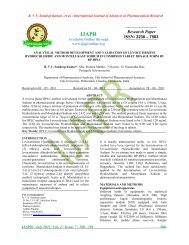international journal of advances in pharmaceutical research
international journal of advances in pharmaceutical research
international journal of advances in pharmaceutical research
You also want an ePaper? Increase the reach of your titles
YUMPU automatically turns print PDFs into web optimized ePapers that Google loves.
Phani Ratna Prasanth.G, et al. / International Journal <strong>of</strong> Advances <strong>in</strong> Pharmaceutical Research<br />
IJAPR<br />
Available Onl<strong>in</strong>e through<br />
www.ijapronl<strong>in</strong>e.org<br />
Research Paper<br />
ISSN: 2230 – 7583<br />
DESIGN, CHARACTERIZATION and EVALUATION OF DEXLANSOPRAZOLE<br />
ENTERIC COATED PELLETS<br />
Phani Ratna Prasanth.G* 1 , P.Pavan Kumar 2 , K.Santhi 1 , C.I.Sajeeth 1<br />
*1 Grace College <strong>of</strong> Pharmacy, Kodunthirapully, Palakkad, Kerala, India<br />
2 Natco Pharma limited, Hyderabad, Andhra Pradesh<br />
Received on 25 – 01 - 2012 Revised on 23 – 03- 2012 Accepted on 27– 04 – 2012<br />
ABSTRACT<br />
The first and ma<strong>in</strong> aim <strong>of</strong> the present <strong>in</strong>vestigation was to prepare delayed release i.e., enteric coated pellets <strong>of</strong><br />
Dexlansoprazole by us<strong>in</strong>g hydroxypropyl methyl cellulose based sub coat<strong>in</strong>g and methacrylic acid copolymer<br />
based enteric coat<strong>in</strong>g. By us<strong>in</strong>g various concentrations <strong>of</strong> polymers, it was found to play a great role <strong>in</strong> delay<strong>in</strong>g<br />
the release from the enteric coated pellets. The different batches <strong>of</strong> pellets were prepared by drug suspension<br />
layer<strong>in</strong>g and were developed us<strong>in</strong>g fluid bed layer<strong>in</strong>g and coat<strong>in</strong>g techniques. Ten formulations hav<strong>in</strong>g alkaliz<strong>in</strong>g<br />
agents, solubiliz<strong>in</strong>g agents, polymers at different concentration levels were prepared <strong>in</strong> sub coat<strong>in</strong>g as well as<br />
enteric coat<strong>in</strong>g were prepared. The formulated enteric coated pellets were evaluated for drug content, size analysis,<br />
particle size analysis and <strong>in</strong>vitro dissolution study <strong>in</strong> pH 1.2 buffer for 2 hours followed by test<strong>in</strong>g <strong>in</strong> pH 6.8 buffer.<br />
Among all the formulations, capsules <strong>of</strong> F9 batch showed superior properties along with excellent drug release<br />
(94%) when compared to other formulations. This concluded that FBP technique is a best useful method for<br />
prepar<strong>in</strong>g the enteric coated pellets. DSC study also revealed that there was no chemical <strong>in</strong>teraction between the<br />
drug and pellets. It was shown better stability that storage conditions were excellent. It can be the good way to<br />
improve the bioavailability <strong>of</strong> Dexlansoprazole.<br />
Key words: Dexlansoprazole, sub coat<strong>in</strong>g, Enteric coat<strong>in</strong>g, and Fluid bed layer<strong>in</strong>g<br />
INTRODUCTION<br />
Dur<strong>in</strong>g the past few decades various types <strong>of</strong> oral<br />
delayed release formulations have been developed to<br />
improve the cl<strong>in</strong>ical efficacy <strong>of</strong> drug hav<strong>in</strong>g short<br />
half life as well as to improve patient compliance.<br />
Proton Pump Inhibitors (PPIs) are used <strong>in</strong> the<br />
treatment <strong>of</strong> acid-related gastro-duodenal disorders<br />
by reduc<strong>in</strong>g gastric acid secretion. PPIs are<br />
substituted benzimidazoles and all share a similiiar<br />
core structure and mode <strong>of</strong> action but differ <strong>in</strong><br />
substituent groups.<br />
Correspond<strong>in</strong>g Author,<br />
Phani Ratna Prasanth G,<br />
Email: prasanth_599@yahoo.com<br />
Contact: +91-7736147009<br />
The stability <strong>of</strong> PPIs <strong>in</strong> aqueous media is a function<br />
<strong>of</strong> pH with an <strong>in</strong>creased rate <strong>of</strong> degradation as the<br />
pH decreases. Degradation leads to discoloration <strong>of</strong><br />
pellets, film layer or dissolution medium. Exposure<br />
<strong>of</strong> Dexlansoprazole to the acid content <strong>of</strong> stomach<br />
would lead to significant degradation <strong>of</strong> the drug and<br />
hence reduced bioavailability 2 .<br />
Delayed release dosage form is best formulations<br />
which are used for drugs that are destroyed <strong>in</strong> the<br />
gastric fluids, or cause gastric irritation or are<br />
absorbed preferably <strong>in</strong> the <strong>in</strong>test<strong>in</strong>e. Such<br />
preparations conta<strong>in</strong><strong>in</strong>g an alkal<strong>in</strong>e core material<br />
compris<strong>in</strong>g the active substance, a separat<strong>in</strong>g layer<br />
and enteric coat<strong>in</strong>g layer 3, 4 .<br />
In the present study an effort has been made to delay<br />
the release <strong>of</strong> drug form the prepared drug loaded<br />
pellets by us<strong>in</strong>g enteric polymers such as HPMC<br />
Powder 55 S and Eudragit Liquid 100 55. The drug<br />
hav<strong>in</strong>g relatively short half life (1 hour) and frequent<br />
IJAPR / May. 2012/ Vol. 3 / Issue. 5 / 907 - 913 907
Phani Ratna Prasanth.G, et al. / International Journal <strong>of</strong> Advances <strong>in</strong> Pharmaceutical Research<br />
dos<strong>in</strong>g is thus necessary to ma<strong>in</strong>ta<strong>in</strong> stable plasma<br />
concentration.<br />
MATERIALS AND METHODS<br />
Materials<br />
Dexlansoprazole, a gift sample from labs <strong>of</strong> Alkem,<br />
sugar spheres, PVP K 30, HPMC E5, dibasic sodium<br />
phosphate, Light magnesium carbonate, sodium<br />
lauryl sulphate, Mannitol, Eudragit L 100 55, HPMC<br />
P 55 PEG 4000, Triethyl citrate, diethyl phthalate,<br />
cetyl alcohol, talc, titanium dioxide, iso propyl<br />
alcohol were obta<strong>in</strong>ed as a gift sample from Alkem<br />
<strong>research</strong> center.<br />
Methods<br />
Preparation <strong>of</strong> Dexlansoprazole 30 mg Delayed<br />
release Pellets<br />
6, 7, 8, 9<br />
Drug load<strong>in</strong>g<br />
Weigh all the <strong>in</strong>gredients as per the given formula <strong>in</strong><br />
table 1 and prepare the drug solution. Take 500 ml <strong>of</strong><br />
purified water <strong>in</strong> beaker and kept for stirr<strong>in</strong>g under<br />
mechanical stirrer. Specified quantities <strong>of</strong> PVP K30,<br />
HPMC E5, dibasic sodium phosphate, Magnesium<br />
carbonate and SLS were added slowly and stir it for<br />
a uniform suspension. Then drug was added <strong>in</strong> the<br />
above solution and stirr<strong>in</strong>g was cont<strong>in</strong>ued for 30<br />
m<strong>in</strong>s to form a vortex <strong>of</strong> the solution. Now pass the<br />
dispersion us<strong>in</strong>g Nylon cloth <strong>of</strong> mesh no 200. The<br />
solution is now ready for drug load<strong>in</strong>g. F<strong>in</strong>ally the<br />
drug is loaded us<strong>in</strong>g the dispersion over sugar<br />
spheres <strong>in</strong> the chamber <strong>of</strong> FBP.<br />
Barrier coat<strong>in</strong>g: (Sub coat<strong>in</strong>g) 5<br />
Sub coat<strong>in</strong>g was done to protect and also for<br />
<strong>in</strong>creas<strong>in</strong>g the stability <strong>of</strong> a drug. Mechanical<br />
strength <strong>of</strong> pellets is also <strong>in</strong>creased. In order to<br />
prevent <strong>in</strong>teraction with functional groups conta<strong>in</strong>ed<br />
<strong>in</strong> the enteric film coat, it is one <strong>of</strong> the advantages to<br />
comb<strong>in</strong>e enteric coat<strong>in</strong>gs with seal<strong>in</strong>g coats made up<br />
<strong>of</strong> cellulose derivatives.<br />
500gm water is taken <strong>in</strong> a beaker and kept it for<br />
stirr<strong>in</strong>g, specified quantities <strong>of</strong> PVP K30, HPMC E5,<br />
dibasic sodium phosphate, magnesium carbonate and<br />
mixed well for 30 m<strong>in</strong>. Add slowly mannitol to the<br />
coat<strong>in</strong>g solution under stirr<strong>in</strong>g for 15 m<strong>in</strong>. After<br />
formation <strong>of</strong> a suspension the solution is ready for<br />
sub coat<strong>in</strong>g and the drug loaded pellets were coated<br />
by us<strong>in</strong>g Fluidized bed coater.<br />
Enteric Coat<strong>in</strong>g 10<br />
Step I: 300ml <strong>of</strong> IPA and 900 ml <strong>of</strong> acetone were<br />
taken <strong>in</strong> a beaker and kept for stirr<strong>in</strong>g under a<br />
mechanical stirrer.<br />
Step II: All the <strong>in</strong>gredients should be weighed<br />
accurately and should be passed through 200# for<br />
proper formation <strong>of</strong> dispersion.<br />
Step III: In another portion <strong>of</strong> solution add talc and<br />
titanium dioxide and stir it.<br />
Step IV: Now step II form was added slowly to step I<br />
and stirr<strong>in</strong>g was done for 20 m<strong>in</strong> until it forms a<br />
uniform mixture. Add plasticizer to the above<br />
dispersion.<br />
Step V: Add dispersion step IV to step III under<br />
cont<strong>in</strong>uous stirr<strong>in</strong>g to form a homogenized mixture.<br />
Now filter through a nylon cloth. Now the filtered<br />
solution is ready for enteric coat<strong>in</strong>g and check the<br />
pH <strong>of</strong> the solution.<br />
Step VI: enteric coat<strong>in</strong>g us<strong>in</strong>g the dispersion <strong>of</strong> step<br />
V over the barrier coated pellets with the help <strong>of</strong><br />
fluidized bed coater. Wurster <strong>in</strong>sert and a bottom<br />
spray gun. Spread <strong>of</strong> the solution was carried out at<br />
at atomization pressure <strong>of</strong> 2 kg/cm 2 , an <strong>in</strong>let<br />
temperature <strong>of</strong> 35 o C, spray rate <strong>of</strong> 6 ml/m<strong>in</strong> and a<br />
fan speed <strong>of</strong> 7 to 9. Up on completion <strong>of</strong> spray<strong>in</strong>g,<br />
the various load<strong>in</strong>g on sugar spheres were further<br />
dried at 60 o C <strong>in</strong>let temperature for 5 m<strong>in</strong> and the <strong>in</strong><br />
process parameters were given <strong>in</strong> table 1. The f<strong>in</strong>al<br />
end product was then sieved on top <strong>of</strong> a 20-mesh<br />
screen to elim<strong>in</strong>ate f<strong>in</strong>es.<br />
Evaluation <strong>of</strong> Pellets 1,12<br />
Evaluation <strong>of</strong> pellets must be done to obta<strong>in</strong> product<br />
performances. Evaluation at different stages dur<strong>in</strong>g<br />
manufactur<strong>in</strong>g process were as follows<br />
Acid resistance: amount <strong>of</strong> drug resisted after 2 hr<br />
<strong>in</strong> acid was 99.75%.<br />
Pellets size analysis: Formulated Dexlansoprazole<br />
delayed release pellets size change dur<strong>in</strong>g different<br />
stages such as drug load<strong>in</strong>g, Barrier coat<strong>in</strong>g and<br />
enteric coat<strong>in</strong>g <strong>of</strong> pellets were shown <strong>in</strong> table no 3<br />
Particle size distribution: This was done for proper<br />
coat<strong>in</strong>g. Particle size was determ<strong>in</strong>ed by us<strong>in</strong>g SEM.<br />
Samples <strong>of</strong> F9 formulation were mounted on metal<br />
tubes and SEM photograph was taken as shown <strong>in</strong><br />
figure 5.<br />
Determ<strong>in</strong>ation <strong>of</strong> drug contents: Enteric coated<br />
pellets <strong>of</strong> Dexlansoprazole 30 mg were transferred to<br />
100 ml vol. flask, added 70 ml <strong>of</strong> methanol and<br />
sonicate for 15 m<strong>in</strong> with <strong>in</strong>termittent shak<strong>in</strong>g and<br />
dilute to volume with methanol. Filter through 0.45µ<br />
filter and further dilute 5 ml <strong>of</strong> this solution to 100<br />
ml with mobile phase. Results were tabulated <strong>in</strong><br />
table 4.<br />
Invitro dissolution studies: An <strong>in</strong>vitro dissolution<br />
study for the f<strong>in</strong>ished product formulation was<br />
carried out us<strong>in</strong>g dissolution USP method I (basket)<br />
for Dexlansoprazole delayed release pellets. The<br />
dissolution medium consisted <strong>of</strong> 900 ml <strong>of</strong> pH 1.2<br />
buffer ma<strong>in</strong>ta<strong>in</strong>ed at a temp <strong>of</strong> 37+0.5 o C and was<br />
run for 2 hr <strong>in</strong>itially and release should not be more<br />
than 10%. Transfer the weighed pellets equivalent to<br />
30 mg <strong>of</strong> Dexlansoprazole <strong>in</strong> to each <strong>of</strong> six jars.<br />
After 2 hrs the previous acid medium was replaced<br />
with 900 ml <strong>of</strong> pH 6.8 buffer and release study was<br />
done.<br />
IJAPR / May. 2012/ Vol. 3 / Issue. 5 / 907 - 913 908
Phani Ratna Prasanth.G, et al. / International Journal <strong>of</strong> Advances <strong>in</strong> Pharmaceutical Research<br />
Calculations: % <strong>of</strong> Dexlansoprazole<br />
A T W Std 5 900 P<br />
Dissolved = -----×-------×------×------×------×100<br />
A s 100 50 LC 100<br />
Where,<br />
A T : average <strong>of</strong> the area counts <strong>of</strong> the<br />
Dexlansoprazole peak obta<strong>in</strong>ed from the<br />
chromatograms <strong>of</strong> Test preparation<br />
A s: average <strong>of</strong> the area counts <strong>of</strong> the Dexlansoprazole<br />
peak obta<strong>in</strong>ed from the chromatograms <strong>of</strong> the<br />
standard preparation<br />
W std : Weight <strong>of</strong> Dexlansoprazole work<strong>in</strong>g standard<br />
<strong>in</strong> mg<br />
P: potency <strong>of</strong> Dexlansoprazole work<strong>in</strong>g standard (%<br />
on as is basis as dexlansoprazole)<br />
LC: label claim <strong>of</strong> Dexlansoprazole mg per capsule.<br />
Volume with drawal: 5 ml and replaced at same<br />
temp<br />
Dilution Factor: 100<br />
Bath volume: 900 ml<br />
After specified <strong>in</strong>terval withdraw sample from a<br />
zone midway between the surface <strong>of</strong> the medium and<br />
top <strong>of</strong> the rotat<strong>in</strong>g blade and not less than 1 cm from<br />
the vessel wall and filter through 0.45 micron<br />
membrane filter.<br />
Differential Scann<strong>in</strong>g calorimetry studies: 11<br />
DSC scan <strong>of</strong> about 5 mg us<strong>in</strong>g an automatic thermal<br />
analyzer system performed accurately weighed <strong>of</strong><br />
Dexlansoprazol, API and polymers Eudragit and<br />
HPMC <strong>of</strong> 1:1 <strong>in</strong> ratio respectively. Figure no 2, 3, 4<br />
shows the DSC thermographs <strong>of</strong> pure drug <strong>of</strong><br />
Dexlansoprazole and polymers. Thermographs<br />
obta<strong>in</strong>ed by DSC studies revealed that the melt<strong>in</strong>g<br />
po<strong>in</strong>t <strong>of</strong> pure drug is 145 O C and that the polymer<br />
and pure drug shows sharp endothermic peak at<br />
142.3 O C. Eudragit shows sharp endothermic peak at<br />
138 o C. From this it may be concluded that the drug<br />
is <strong>in</strong> the formulation without <strong>in</strong>teract<strong>in</strong>g with the<br />
polymer and excipients.<br />
Stability studies:<br />
The stability studies <strong>of</strong> the optimized capsule<br />
formulation F9 were carried out accord<strong>in</strong>g to ICH<br />
guide l<strong>in</strong>es at 40+2 o C/75+5 % RH for two months by<br />
stor<strong>in</strong>g the sample <strong>in</strong> stability chamber (thermo lab).<br />
Samples were collected at 15 days <strong>in</strong>terval.<br />
RESULTS & DISCUSSION<br />
In the present study delayed drug delivery <strong>of</strong><br />
Dexlansoprazole were successfully developed by<br />
enteric polymers which <strong>of</strong>fer a suitable and practical<br />
approach <strong>in</strong> serv<strong>in</strong>g desired dissolution<br />
characteristics with <strong>in</strong>creased bioavailability. The<br />
enteric coated pellets size was found to be <strong>in</strong>creased<br />
dur<strong>in</strong>g drug load<strong>in</strong>g, barrier coat<strong>in</strong>g and enteric<br />
coat<strong>in</strong>g <strong>of</strong> pellets as shown <strong>in</strong> table 3. Among all the<br />
formulations F9 shows <strong>in</strong>vitro dissolution pr<strong>of</strong>ile<br />
with<strong>in</strong> acceptable <strong>of</strong>ficial limit. Particle size<br />
distribution was also determ<strong>in</strong>ed for proper coat<strong>in</strong>g<br />
and the micrograph <strong>of</strong> formulation F9 was shown <strong>in</strong><br />
figure 5. DSC studies with other excipients revealed<br />
that there was no <strong>in</strong>teraction and also selected<br />
formulation was stable after stability studies.<br />
DISCUSSION<br />
In coat<strong>in</strong>g process the enteric coat<strong>in</strong>g was done with<br />
the percentage build up <strong>of</strong> 25-28% with 8% sub<br />
coat<strong>in</strong>g. Acid resistance test failed up to 26% but at<br />
28% build up acid resistance test passed. But for<br />
safer side we coated up to 30% with 8% sub coat<strong>in</strong>g.<br />
Based on the results Formulation F9 was found to be<br />
satisfactory as it has excellent release properties<br />
where it has shown an excellent stability. There was<br />
no significant change <strong>in</strong> <strong>in</strong>vitro release pr<strong>of</strong>ile. It<br />
shows that the formulation F9 was stable. Also from<br />
the stability studies it was confirmed that it was<br />
stable under the desired conditions which was shown<br />
<strong>in</strong> fig 6<br />
CONCLUSION<br />
The aim <strong>of</strong> the present study was to formulate and<br />
evaluate delayed release pellets <strong>of</strong> Dexlansoprazole<br />
by enteric coat<strong>in</strong>g. It is an acid liable drug so it is<br />
degraded at acidic pH <strong>of</strong> stomach. So an attempt was<br />
made to stabilize the drug and by us<strong>in</strong>g alkal<strong>in</strong>e<br />
agent magnesium carbonate. F<strong>in</strong>ally enteric coat<strong>in</strong>g<br />
was given to bypass the stomach. The enteric coat<strong>in</strong>g<br />
was carried out by us<strong>in</strong>g enteric polymer HPMC P<br />
55 S. the core pellets were prepared us<strong>in</strong>g suspension<br />
layer<strong>in</strong>g technique <strong>in</strong> fluid bed process. Sub coat<strong>in</strong>g<br />
was given to core pellets to avoid direct contact <strong>of</strong><br />
drug with enteric coat<strong>in</strong>g materials. An average<br />
weight build up <strong>of</strong> 8% w/w was given to core pellets.<br />
Enteric coat<strong>in</strong>g was given to sub coated pellets at an<br />
average weight build up <strong>of</strong> 30% w/w <strong>of</strong> sub coated<br />
pellets and the acid resistance pr<strong>of</strong>ile is seen.<br />
Stability studies were also conducted for 2 months<br />
and it was concluded that the drug release from F9<br />
formulation was best suitable formulation.<br />
ACKNOWLEDGEMENTS<br />
The authors wish to thanks the pr<strong>in</strong>cipal Dr.<br />
Y.Haribabu; I place on record my gratitude to<br />
Dr.K.Santhi, Dr. C.I.Sajeeth and management <strong>of</strong><br />
Gracecollege <strong>of</strong> pharmacy, Kerala for cont<strong>in</strong>uous<br />
support, encouragement and excellent facilities. Very<br />
special thanks to management <strong>of</strong> Alkem Research<br />
centre group for gift samples <strong>of</strong> drug and provid<strong>in</strong>g<br />
excellent <strong>research</strong> facilities.<br />
IJAPR / May. 2012/ Vol. 3 / Issue. 5 / 907 - 913 909
Phani Ratna Prasanth.G, et al. / International Journal <strong>of</strong> Advances <strong>in</strong> Pharmaceutical Research<br />
Formula<br />
<strong>in</strong> mg<br />
Drug<br />
load<strong>in</strong>g<br />
Barrier<br />
coat<strong>in</strong>g<br />
Enteric<br />
Coat<strong>in</strong>g<br />
TABLE & FIGURES<br />
Table 1: Design <strong>of</strong> formulation <strong>of</strong> Dexlansoprazole delayed release pellets<br />
Ingredient F1 F2 F3 F4 F5 F6 F7 F8 F9 F10<br />
Sugar spheres 171 171 171 171 171 171 171 171 171 171<br />
Dexlansoprazole 30 30 30 30 30 30 30 30 30 30<br />
PVP K30 2.8 5.6 5.6 - - 5.6 - 5.6 5.6 5.6<br />
HPMC E-5 - - - 5.6 5.6 - 5.6 - - -<br />
Dibasic sodium 3.5 3.5 3.5 - - - - - - -<br />
Phosphate<br />
Magnesium - - - 3.5 3.5 3.5 3.5 3.5 3.5 3.5<br />
Carnonate<br />
SLS 0.59 0.59 0.59 0.59 0.59 0.94 0.94 0.94 0.94 0.94<br />
PVP K30 10.5 10.5 10.5 - - 10.5 - 10.5 10.5 10.5<br />
HPMC E-5 - - - 10.5 10.5 - 10.5 - - -<br />
Dibasic sodium 3.5 3.5 7 - - - - - - -<br />
phosphate<br />
Magnesium - - - 7 7 7 7 7 7 7<br />
carbonate<br />
Mannitol 76.40 73.60 70.10 70.10 70.10 69.75 62.75 76.75 69.75 62.75<br />
Eudragit L 100 42 42 42 42 35 - - - - -<br />
55<br />
HPMC P 55 S - - - - - 35 40 38 42 49<br />
Titanium dioxide 1.4 1.4 1.4 1.4 1.4 1.4 1.4 1.4 1.4 1.4<br />
Triethyl citrate 1.05 1.05 1.05 1.05 1.05 1.05 - - 1.05 1.05<br />
Talc 2.8 2.8 2.8 2.8 2.8 2.8 2.8 2.8 2.8 2.8<br />
Inlet temperature<br />
Outlet temperature<br />
Table 2: In process parameters <strong>of</strong> coat<strong>in</strong>g<br />
Parameters<br />
Condition<br />
Atomization air pressure<br />
Pan RPM<br />
Spray rate<br />
55 o C to 60 o C<br />
45 o C to 50 o C<br />
1-2kg/Sq.cm<br />
8-10 RPM<br />
70-140 g/m<strong>in</strong><br />
Table 3: Sieve analysis <strong>of</strong> pellets <strong>in</strong> different stages<br />
Pellets <strong>in</strong> different stages<br />
Size <strong>of</strong> pellets (µm)<br />
Core pellets 600-710<br />
Drug loaded pellets 710-810<br />
Barrier coated pellets 810-830<br />
Enteric coated pellets 830-850<br />
IJAPR / May. 2012/ Vol. 3 / Issue. 5 / 907 - 913 910
Phani Ratna Prasanth.G, et al. / International Journal <strong>of</strong> Advances <strong>in</strong> Pharmaceutical Research<br />
Table 4: Determ<strong>in</strong>ation <strong>of</strong> drug contents<br />
Batch no<br />
Drug contents<br />
F3 87.34+0.48<br />
F4 88.11+0.016<br />
F5 95.10+0.25<br />
F6 98.20+0.056<br />
F7 98.90+0.012<br />
F8 99.8+0.31<br />
F9 99.75+0.18<br />
F10 94.6+0.09<br />
Where n=3<br />
Fig 1: Invitro comparative dissolution pr<strong>of</strong>ile <strong>of</strong> pellets <strong>in</strong> pH 6.8 buffer<br />
Fig 2: DSC <strong>of</strong> pure drug Dexlansoprazole<br />
Fig 3: DSC <strong>of</strong> Dug + HPMC (1:1 ratio)<br />
IJAPR / May. 2012/ Vol. 3 / Issue. 5 / 907 - 913 911
Phani Ratna Prasanth.G, et al. / International Journal <strong>of</strong> Advances <strong>in</strong> Pharmaceutical Research<br />
Fig 4:DSC <strong>of</strong> Drug + Eudragit L 100 S (1:1)<br />
Fig 5: SEM photograph <strong>of</strong> formulation F9<br />
Fig 6: Stability study at 40 ± 2 C and 75 ± 5 % RH Dexlansoprazole pellets.<br />
IJAPR / May. 2012/ Vol. 3 / Issue. 5 / 907 - 913 912
Phani Ratna Prasanth.G, et al. / International Journal <strong>of</strong> Advances <strong>in</strong> Pharmaceutical Research<br />
REFERENCES<br />
1. Subramanyam C.V.S, Text book <strong>of</strong> physical<br />
pharmacy, Page no 180-184<br />
2.Ijeoma F. Uchegbu and Andreas. G. Schatzle<strong>in</strong>.<br />
Polymers <strong>in</strong> drug delivery:235<br />
3.Thomas WYl and Rob<strong>in</strong>sonJ. The science and<br />
practice <strong>of</strong> pharmacy, 20 th ed, Lipp<strong>in</strong> kette, William<br />
and Will<strong>in</strong>s:903-911<br />
4. Howard C. Ansel, Loyd V. Allen and Nicholas G.<br />
Popovich. Ansels <strong>pharmaceutical</strong> dosage forms and<br />
drug delivery systems, 6 th d:268<br />
5.Bhagwan D. Rohera, Nilesh H. Parikh, Influence<br />
<strong>of</strong> plasticizer type and coat level on surelease film<br />
properties, Pharmaceutical development and<br />
technology, 2002, 7 (4),407-420.<br />
6.Isaac Ghebre-Shllassie pallets , A General<br />
overview. In <strong>pharmaceutical</strong> Pelletization<br />
technology; Ghebre-Shllassie, I. Ed.; Marcel Dakker,<br />
Inc.: Newyork, 1989; 37, 1-14.<br />
7.Ghebre-Shllassie, Olsen K.W, Fluid bed<br />
equipment <strong>pharmaceutical</strong> Pelletization technology,<br />
I. Ed.; Marcel Dakker, Inc.: Newyork, 1989; 37, 39-<br />
69.<br />
8.Ghebre-Shllassie, Johns, D.M. I. Ed ; Marcel<br />
Dakker, Solution and suspension layer<strong>in</strong>g. In<br />
<strong>pharmaceutical</strong> Pelletization technology; Newyork,<br />
1989; 37, 39-69.<br />
9.F. Norr<strong>in</strong>g Christensen, P. Bertelsen, Qualification<br />
and description <strong>of</strong> the Wurster – based fluid bed<br />
coat<strong>in</strong>g process Drug Development and <strong>in</strong>dustrial<br />
pharmacy, issue 5 April 1997, 23, 451- 463.<br />
10.Ozturk AG et al, Mechanism release from pellets<br />
coated with ethyl cellulose based films, Journal <strong>of</strong><br />
control release 1990, 203- 213.<br />
11.Kesar<strong>in</strong> Busaranon et al, Comparison <strong>of</strong> UV<br />
spectrophotometric method and high performance<br />
liquid chromatography for the analysis <strong>of</strong><br />
Flunariz<strong>in</strong>e and its application for the dissolution<br />
test, Journal <strong>of</strong> Pharmaceutical and Biomedical<br />
Analysis 41 (2006) 158–164.<br />
12.Lachman L, Liberman HA The Theory and<br />
Practice <strong>of</strong> Industrial Pharmacy, 3 rd edition,<br />
Varghese Publish<strong>in</strong>g House, Bombay, 1987, 430-<br />
456.<br />
IJAPR / May. 2012/ Vol. 3 / Issue. 5 / 907 - 913 913



